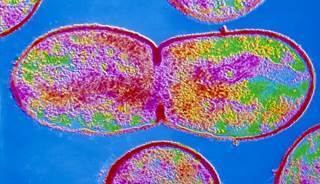Order Lactobacillales Rank Species | Scientific name Streptococcus bovis Higher classification Streptococcus | |
 | ||
Similar Bacteria, Streptococcus mitis, Streptococcus sanguinis, Streptococcus salivarius, Streptococcus anginosus | ||
Streptococcus bovis
Streptococcus gallolyticus, formerly Streptococcus bovis (S. bovis) is a species of Gram-positive bacteria that in humans is associated with endocarditis and colorectal cancer. S. bovis is commonly found in the alimentary tract of cattle, sheep, and other ruminants, and may cause ruminal acidosis or feedlot bloat. It is also associated with spontaneous bacterial peritonitis, a frequent complication occurring in patients affected by cirrhosis.
Contents
- Streptococcus bovis
- Medical vocabulary what does streptococcus bovis mean
- Classification
- Entry
- Role in disease
- Ruminal effects
- References

Medical vocabulary what does streptococcus bovis mean
Classification
S. bovis is a catalase- and oxidase-negative, nonmotile, nonsporulating, Gram-positive lactic acid bacterium that grows as pairs or chains of cocci. It is a member of the Lancefield group D streptococci. Most strains are non- or gamma-hemolytic, but some also display alpha-hemolytic activity on ovine blood agar plates.
Entry

The main portal of entry for human infection of S. bovis bacteremia is the gastrointestinal tract, but in some cases, entry is through the urinary tract, the hepatobiliary tree, or the oropharynx.
Role in disease

S. bovis is a known human pathogen that has been implicated as a causative agent of endocarditis, urinary tract infections, and more rarely, septicemia and neonatal meningitis.
S. bovis has long been associated with colorectal cancer (CRC); however, not all genospecies are as closely related to CRC. A recent meta-analysis on the association between S. bovis biotypes and colonic adenomas/carcinomas revealed that patients with S. bovis biotype I infection had a strongly increased risk of having CRC (pooled odds ratio: 7.26; 95% confidence interval: 3.94–13.36), compared to S. bovis biotype II-infected patients. This analysis clearly indicates that S. bovis should no longer be regarded as a single bacterial entity in clinical practice. Only Streptococcus gallolyticus (the new name of S. bovis biotype I) infection has an unambiguous association with colonic adenomas/carcinomas (prevalence range: 33–71%) that markedly exceeds the prevalence of colonic (pre-)maligancies in the general population (10–25%). Nevertheless, research has not yet determined if S. gallolyticus is a causative agent of colorectal cancer, or if pre-existing cancer makes the lumen of the large intestine more hospitable to its outgrowth.
Ruminal effects
When ruminants consume diets high in starch or sugar, these easily fermentable carbohydrates promote the proliferation of S. bovis in the rumen. Because S. bovis is a lactic acid bacterium, fermentation of these carbohydrates to lactic acid can cause a dramatic decline in ruminal pH, and subsequent development of adverse conditions such as ruminal acidosis or feedlot bloat.
